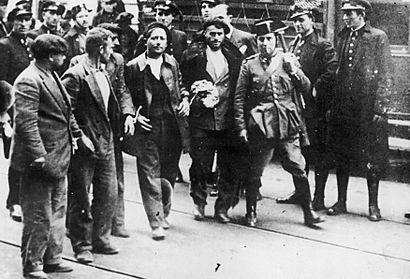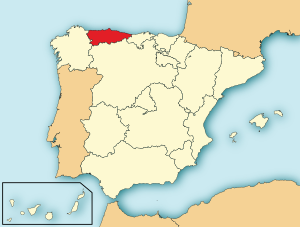Asturian miners' strike of 1934 facts for kids
Quick facts for kids Asturian miners' strike of 1934 |
|||
|---|---|---|---|
| Part of the Revolution of 1934 | |||

Striking workers arrested by Guardia de Asalto and Guardia Civil police forces during the Asturian insurrection
|
|||
| Date | 4–19 October 1934 | ||
| Location |
Asturias, Spain
|
||
| Caused by | Asturian miners strike | ||
| Resulted in | Strike suppressed | ||
| Parties to the civil conflict | |||
|
|||
| Lead figures | |||
|
|
|||
| Casualties | |||
|
|||
The Asturian miners' strike of 1934 was a big protest by miners in Asturias, a region in northern Spain. It happened from October 4 to 19, 1934. The miners were upset about the new government, which was led by a conservative political group called CEDA.
This strike quickly turned into a violent uprising. The goal was to overthrow the government. The rebels took control of Asturias by force. They caused a lot of damage and violence, especially against police and religious leaders. They used dynamite, rifles, and machine guns. They also destroyed many religious buildings like churches. The rebels declared a "proletarian revolution" and set up their own local government.
The Spanish government sent the Spanish Navy and the Spanish Republican Army to stop the rebellion. Many of the soldiers were colonial troops from Spanish Morocco. The war minister, Diego Hidalgo, wanted Francisco Franco to lead the troops. However, Spain's president, Alcalá Zamora, chose General Eduardo López Ochoa instead. He hoped this would reduce the violence. Soldiers from the Civil Guard, colonial troops, and the Spanish Legion were sent under López Ochoa and Colonel Juan Yagüe. Their job was to help government forces and take back the towns from the miners. The rebellion was put down quickly. Many historians see this event as a key moment leading up to the Spanish Civil War.
Contents
Why the Strike Happened
After the 1933 elections, a conservative group called the Spanish Confederation of the Autonomous Right (CEDA) won the most votes. However, the president, Alcalá-Zamora, did not immediately ask CEDA's leader, Gil Robles, to form a government. Instead, he asked Alejandro Lerroux from the Radical Republican Party.
For almost a year, CEDA, even though it was the largest party, was not given any government jobs. After a lot of political pressure, CEDA finally got three positions in the government. This was a normal part of how a democracy works, but many on the left side of politics did not like it. They saw CEDA as a threat to the Republic.
CEDA wanted to change the country's constitution. They aimed to create a new system that would protect "Christian civilization" from left-wing ideas. Their leader, José María Gil-Robles, even said he wanted to give Spain "a totalitarian polity." This meant a government with total control, which worried many people. CEDA also held rallies that looked like those of fascist groups in other countries. They called Gil-Robles "Jefe," which is like "Duce" (the title used by Italy's fascist leader). This made many people fear that Spain was heading towards a dictatorship or a return to monarchy. This fear made some radical left-wing groups believe that a revolution was necessary.
Getting Ready for the Uprising
The rebels had gathered many rifles and pistols. General Emilio Mola even called them the "best armed" of all the left-wing uprisings in Europe at that time. Many of these weapons came from a shipment organized by Indalecio Prieto, a socialist leader. He quickly fled to France to avoid being arrested.
Other weapons came from captured factories in the region. The miners also used their dynamite blasting charges, which they called "the artillery of the revolution." Plans to get police and army units to join the rebels did not work. Even those with some left-wing ideas refused to join.
Most planned armed revolts by other groups did not happen or were easily stopped. For example, a "Catalan State" declared by Catalan leader Lluís Companys lasted only ten hours. In Madrid, strikers briefly took over some buildings but were quickly rounded up. This meant that the Asturian strikers were left to fight alone.
Anarchist and communist groups in Spain had called for general strikes. However, there were disagreements between the Spanish Socialist Workers' Party (PSOE)-linked Unión General de Trabajadores (UGT), which organized the strike, and the anarcho-syndicalist trade union, the Confederación Nacional del Trabajo (CNT). Because of these differences, the strikes failed in most parts of the country.
The Strike and Uprising
In several coal mining towns in Asturias, local unions had collected small weapons. The strike began on the evening of October 4. Miners quickly took over several towns. They attacked and seized local Civil and Assault Guard police barracks.
Early on October 5, 1934, the rebels attacked a school in Turón. The teachers and a priest were captured and later killed by the revolutionary committee. In total, 34 priests, six young students (aged 18-21), and several businessmen and civil guards were killed by the revolutionaries in Mieres and Sama. Also, 58 religious buildings, including churches and convents, and part of the university in Oviedo were burned and destroyed.
On the same day, large groups of miners marched towards Oviedo, the capital city of Asturias. By October 6, the city was taken by the rebels, except for two barracks where government troops continued to fight. The miners then occupied other towns, like the industrial center of La Felguera. They set up "revolutionary committees" to govern the areas they controlled.
By taking Oviedo, the rebels got hold of the city's arsenal. They gained 24,000 rifles, carbines, and machine guns. They also started drafting all workers between 18 and 40 years old into their "Red Army." Within ten days, 30,000 workers were ready for battle. In the areas they controlled, the rebels officially declared a "proletarian revolution" and stopped using regular money. The revolutionary soviets (councils) tried to keep order. Moderate socialist leaders like Ramón González Peña and Belarmino Tomás tried to limit the violence.
Stopping the Rebellion
On October 7, delegates from the anarchist-controlled seaport towns of Gijón and Avilés came to Oviedo. They asked for weapons to defend against government troops landing by sea. However, the socialist UGT-controlled committee ignored them. The delegates returned empty-handed. As a result, government troops faced little resistance when they recaptured Gijón and Avilés the next day.
On the same day, a navy ship called the Libertad and two gunboats arrived in Gijón. They fired on the workers near the shore. Bombers also attacked coalfields and Oviedo. After two weeks of intense fighting, the rebellion was stopped. Between 1,200 and 2,000 people died during the uprising. General López Ochoa even executed some of his own soldiers for mistreating prisoners. Historian Javier Tusell says that while Franco was involved in giving orders from Madrid, it was López Ochoa who was in charge on the ground and could not stop the violence.
What Happened Next
After the strike, Spain's prime minister, Lerroux, was seen by many as the country's "savior." On the other hand, groups of socialists, anarchists, and communists spread messages that justified the rebellion. They presented the crackdown as a terrible act against them.
About 1,500 miners were killed during the uprising. Between 30,000 and 40,000 were taken prisoner, and thousands more lost their jobs. According to Hugh Thomas, a total of 2,000 people died. This included 230-260 military and police, 33 priests, 1,500 miners in combat, and 200 people killed during the government's crackdown. About 15 million pesetas (Spanish money) were stolen from banks. Most of this money was never found and was later used to fund more revolutionary activities.
The political right demanded harsh punishments for those involved in the uprising. The political left, however, asked for forgiveness, saying it was just a labor strike and protest that got out of control. The government reacted in different ways. They temporarily stopped some constitutional rights. Almost all left-wing newspapers were closed because they belonged to the parties that supported the uprising. Many local councils and juries were also suspended.
Support for fascism (a type of extreme right-wing government) remained small in Spain. By 1935, civil liberties (basic rights) were fully restored. This gave the revolutionaries a chance to try to gain power through elections again. Ramón González Peña, a leader of the Oviedo Revolutionary Committee, was sentenced to death but was later pardoned. He later became president of the Unión General de Trabajadores and even served as Minister of Justice from 1938 to 1939. After the Spanish Civil War, González Peña went to live in Mexico, where he died in 1952.
Franco believed the uprising was "carefully prepared by the agents of Moscow" (meaning, by communists). Historian Paul Preston noted that Franco used Moorish soldiers from North Africa to fight in Asturias. Franco saw no problem with this, as he viewed the left-wing workers with the same strong dislike he had for the tribesmen in North Africa. After the rebellion was put down, Franco visited Oviedo. He said that "this war is a frontier war and its fronts are socialism, communism and whatever attacks civilization in order to replace it with barbarism." The right-wing newspapers described the Asturian rebels in very negative ways, linking them to foreign "Jewish-Bolshevik" plots. Franco believed the government needed to punish the rebels severely to prevent future uprisings.
Leading to the Civil War
Many historians see the Asturian uprising as the "first battle" or a "preview" of the Spanish Civil War. The leaders of the left never publicly admitted they were wrong for using violence in Asturias. However, they did accept that they couldn't use such methods to gain power right away.
The stopping of the Asturian rebellion strengthened the connection between the Republican right and the national army. When the Popular Front (a group of left-wing parties) was formed in 1936, one of its promises was to free all those imprisoned for the Asturian rebellion. This promise angered the Spanish right. They saw freeing people who had violently rebelled against the elected government as a sign that the Spanish left would not respect the law.
When the Spanish Civil War started, López Ochoa was in a military hospital. He was waiting for a trial, accused of being responsible for the deaths of 20 civilians in Oviedo. Because of the unrest happening in Madrid, the government tried to move Ochoa to a safer place. However, large angry crowds stopped them twice. A third attempt was made by pretending Ochoa was already dead. But the trick was found out, and the general was taken away. Paul Preston says that an anarchist dragged him from his coffin and shot him in the hospital garden. His head was cut off, put on a pole, and shown in public. His remains were then displayed with a sign that said, "This is the butcher of Asturias."
The eight martyrs of Turon (the teachers and priest killed in Turón) were honored on September 7, 1989. They were later declared "blessed" by Pope John Paul II.
See also
 In Spanish: Revolución de Asturias de 1934 para niños
In Spanish: Revolución de Asturias de 1934 para niños
Images for kids



